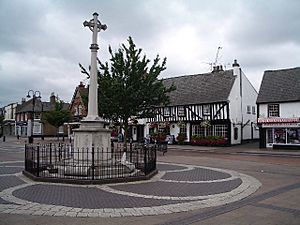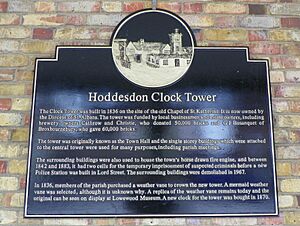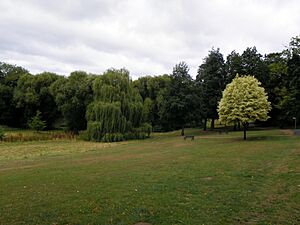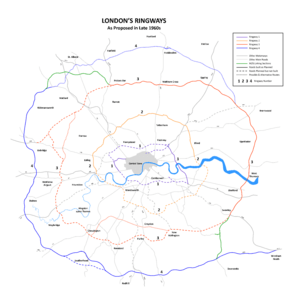Hoddesdon facts for kids
Quick facts for kids Hoddesdon |
|
|---|---|
| Town | |
 Hoddesdon Town Centre |
|
| Population | 42,253 (2011 Census, Built-up area sub division) |
| OS grid reference | TL365085 |
| District |
|
| Shire county | |
| Region | |
| Country | England |
| Sovereign state | United Kingdom |
| Post town | HODDESDON |
| Postcode district | EN11 |
| Dialling code | 01992 |
| Police | Hertfordshire |
| Fire | Hertfordshire |
| Ambulance | East of England |
| EU Parliament | East of England |
| UK Parliament |
|
Hoddesdon (/ˈhɒdzdən/) is a town in Hertfordshire, England. It is part of the Borough of Broxbourne. The town is located within the larger London metropolitan area. Hoddesdon sits near the River Lea and the New River.
In 2011, about 42,253 people lived in Hoddesdon. This makes it the second largest town in the Broxbourne area. It is next to Ware to the north and Broxbourne to the south. The Prime Meridian line passes just east of the town. You can reach Hoddesdon by train at Rye House railway station or Broxbourne railway station.
Contents
History of Hoddesdon
Early Beginnings
The name "Hoddesdon" might come from an old Saxon or Danish name. It is combined with the Old English word "don," which means a hill. The town is first mentioned in the Domesday Book. This was a big survey of England from 1086.
Hoddesdon was an important stop on the main road from London to Cambridge. It was about 20 miles north of London. The road split in the town centre. Many inns were built along the streets to serve travellers. In 1253, the town was given permission to hold a market.
A small hospital was built in the south of Hoddesdon by the 14th century. It was called the Hospital of St Laud and St Anthony. Even after many monasteries were closed, this hospital lasted until the mid-1500s. A stream called Spital Brook reminds us of its name today.
Chapels and Charters
In 1336, a small church called St Katharine's Chapel was built. It was used by people travelling to a holy place in Walsingham. This chapel was taken down in the 1600s. Later, in 1835, the Hoddesdon Town Hall was built on the same spot. Only its clock tower remains today.
Hoddesdon grew a lot during the time of Queen Elizabeth I. Many inns from this period are still in the High Street. The Queen gave the town a special royal charter in 1559. This charter allowed the town to have its own government. It also set up a free grammar school. However, neither the town government nor the school lasted very long.
Sir William Cecil bought land in Hoddesdon in 1567. He was an important advisor to Queen Elizabeth. The Cecil family kept a connection with the town. This is why a local inn is called The Salisbury Arms.
In 1622, Sir Marmaduke Rawdon built Rawdon House. This red-brick house is still standing. Rawdon also gave the town its first public water supply.
The Rye House Plot
In 1683, a secret plan called the Rye House Plot happened near Hoddesdon. Some people wanted to harm King Charles II. They planned to attack him near Rye House as he travelled. The King left earlier than expected, so the plot failed.
Rye House later became a fun place for visitors. In 1870, the owner opened a pleasure garden. He even displayed the famous Great Bed of Ware there. It was so popular that a special train station was built for it.
However, by the early 1900s, fewer tourists came. Most of Rye House was taken down, except for the Gatehouse. The Great Bed was moved to the Victoria & Albert Museum.
Today, Rye House Gatehouse is a very old and important building. You can visit it during the summer. It has displays about the plot and how old bricks were made.
Modern Hoddesdon
A new church, St Paul's, was built in 1732. It became the main church for Hoddesdon in 1844. Before this, Hoddesdon was split between two different church areas. A special stone in the High Street marks the old boundary.
Brewing beer started in Hoddesdon around 1700. In 1803, William Christie opened a large brewery. It became one of the biggest in England and employed many people. The brewery closed in 1928. Some parts of the old brewery buildings can still be seen on Brewery Road.
By the mid-1800s, Hoddesdon was still mainly one long street. It had about 1,743 people. The town was known for its hops market. Today, a market is still held every Wednesday and Friday.
After World War II
After the Second World War, Hoddesdon became a "dormitory town". This means many people lived there but travelled to London for work. In the 1960s and 1970s, parts of the town centre were rebuilt. New shopping areas like the Tower Centre were added. A new road was built in 1974. This helped reduce traffic going through the town.
Hoddesdon has a large Italian community. Many families from Sicily came to the Lea Valley in the 1950s and 60s. They worked in the local plant nurseries. Their families still live in the area today. The Lea Valley is famous for its fresh produce. Most of the cucumber and pepper farms are owned by people of Sicilian descent.
The Italian community celebrates its heritage. The Festival of San Antonio is held in June with a street procession.
In 1951, Hoddesdon hosted an important meeting of architects and town planners. They discussed how to rebuild cities damaged during World War Two.
Recent Changes
In 2007, Rye House Kart Raceway was taken over by local business owners. It is now a very popular place for go-karting.
In 2014, a new pub called The Star opened in Hoddesdon. During its renovation, old wall paintings from the 1500s were found. They show figures and Bible verses. Roof beams from the mid-1400s were also found. This suggests The Star is older than people thought.
Local Government
Hoddesdon has two levels of local government. These are the Broxbourne Borough Council and the Hertfordshire County Council. There has not been a separate town council for Hoddesdon since 1974.
| Hoddesdon | |
| Geography | |
| HQ | Hoddesdon |
| History | |
| Created | 31 December 1894 |
| Abolished | 31 March 1974 |
| Succeeded by | Broxbourne |
| Demography | |
|---|---|
| 1901 population | 4,711 |
| 1971 population | 25,880 |
Hoddesdon used to be a small part of the Broxbourne parish. In 1844, it became its own church parish. For local government, Hoddesdon was split between Broxbourne and Great Amwell. In 1894, Hoddesdon became an "urban district." This meant it had its own local council.
In 1935, the Hoddesdon urban district grew bigger. It took in parts of nearby areas like Broxbourne and Wormley. The council offices were built in 1936.
In 1974, the Hoddesdon Urban District was joined with Cheshunt Urban District. Together, they formed the Borough of Broxbourne. The old council offices were later turned into homes.
Education
Hoddesdon has several schools for young people.
- The John Warner School is a comprehensive school for students aged 11 to 18. It is known for its science and sport programs. In 2007, it was named one of the most improved schools in the country.
- Sheredes School served the area from 1969. It was known for its arts programs. In 2016, Sheredes became Robert Barclay Academy. This is also a comprehensive school for 11 to 18-year-olds.
Sport and Leisure
Hoddesdon offers many activities for fun.
- There is a gym in the town centre.
- The John Warner sports centre has a swimming pool and a children's activity area.
- The town has a football club called Hoddesdon Town F.C.. They play at Lowfield.
- There is a large go-kart track nearby in Rye Park.
- Rye House Stadium used to be home to the Rye House Rockets speedway team.
Media
Hoddesdon is covered by BBC London and ITV London for television. Local radio stations include BBC Three Counties Radio, Heart Hertfordshire, and Mix 92.6. The local newspaper is the Hoddesdon & Broxbourne Mercury.
Transport
Railway Services
Greater Anglia runs local train services. The closest train stations to Hoddesdon are:
- Broxbourne station: Trains go to Cambridge North and London Liverpool Street. They also go between Hertford East and Liverpool Street.
- Rye House station: Trains run between Hertford East and Liverpool Street.
Roads
A small part of the London Ringways plan was built in Hoddesdon. This was a big road scheme from the 1960s.
The A1170 Dinant Link Road connects the town to the A10. It has a very large junction. This was built to allow the road to continue further west over the A10 in the future.
Bus Services
Local bus services are run by several companies. These include Arriva Herts & Essex, Central Connect, and Uno. Buses connect Hoddesdon to nearby towns like Broxbourne, Harlow, Hertford, and Ware.
Notable People
Many interesting people have connections to Hoddesdon:
- Harriet Auber (1773–1862), a poet and hymn writer.
- Arthur James Balfour, 1st Earl of Balfour (1848–1930), a former Prime Minister of the United Kingdom. He went to school in Hoddesdon.
- William Ellis (1794–1872), a missionary and author. He lived in Hoddesdon.
- William Christie Gosse (1842–1881), an explorer and surveyor. He was born in Hoddesdon.
- John Loudon McAdam (1756–1836), an engineer famous for building roads. He lived in the town.
- Hugh Paddick (1915–2000), a comedy actor. He was born in Hoddesdon.
- Richard Rumbold (c 1622–1685), a soldier involved in the Rye House Plot.
- Lena Zavaroni (1963–1999), a popular singer. She spent some of her last years in Hoddesdon.
- Erik Thorstvedt (1962), a Norwegian footballer who played for Tottenham Hotspur. He lived in Hoddesdon.
- Gino D'Acampo (1976), a famous Italian-British chef. He currently lives in Hoddesdon.
Images for kids
See also
 In Spanish: Hoddesdon para niños
In Spanish: Hoddesdon para niños






